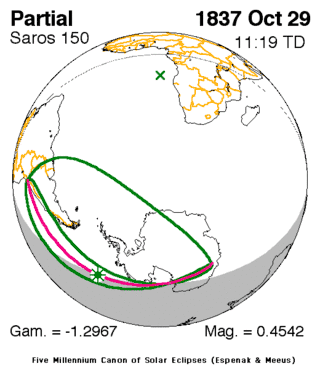Solar eclipse of October 29, 1837
A partial solar eclipse occurred on October 29, 1837 during spring. A solar eclipse occurs when the Moon passes between Earth and the Sun, thereby totally or partly obscuring the image of the Sun for a viewer on Earth. A partial solar eclipse occurs in the polar regions of the Earth when the center of the Moon's shadow misses the Earth.
| Solar eclipse of October 29, 1837 | |
|---|---|
 Map | |
| Type of eclipse | |
| Nature | Partial |
| Gamma | -1.2967 |
| Magnitude | 0.4542 |
| Maximum eclipse | |
| Coordinates | 61.9°S 110.5°W |
| Times (UTC) | |
| Greatest eclipse | 11:19:24 |
| References | |
| Saros | 150 (7 of 71) |
| Catalog # (SE5000) | 9133 |
It was the last of three partial eclipses that took place that year, the first of two in two months, the last was on May 4 which covered a part of the Northern Hemisphere.[1] It was part of solar saros 150.[2]
Description
The eclipse was visible in much of Antarctica with the exception of most of the northern and northeastern parts, it included most of southern South America, the South Zetland Islands and the South Orkney Islands. The edge of the eclipse included Paraguay (parts are now in Argentina) and southern Brazil.
The eclipse started at sunrise in Chile south of Antofagasta and finished at sunset in Antarctica.
It showed about up to 10% obscurity in the South Pole area and in Uruguay, 20 to 35% at the Antarctic Peninsula and Patagonia. The greatest eclipse was in Antarctica at 61.9 S, 110.5 W at 11:19 UTC (4:19 AM local time).[1]
The subsolar marking was west of Angola in Africa.
See also
- List of solar eclipses in the 19th century
- List of solar eclipses visible from Antarctica
- List of solar eclipses visible from Brazil
References
- "Solar eclipse of October 29, 1837". NASA. Retrieved March 13, 2017.
- "Solar Saros 150". NASA. Retrieved March 13, 2017.
.jpg)
